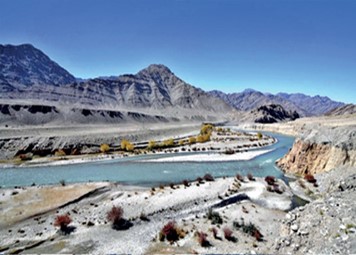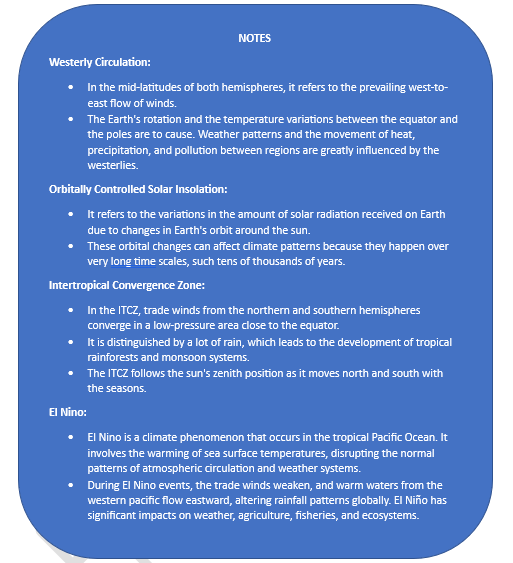- Courses
- GS Full Course 1 Year
- GS Full Course 2 Year
- GS Full Course 3 Year
- GS Full Course Till Selection
- CSAT
- 5 LAYERED ARJUNA Mentorship
- Public Administration Optional
- Online Program
- GS Recorded Course
- NCERT Batch
- Polity Module Course
- Geography Module Course
- Economy Module Course
- AMAC Module Course
- Modern India, Post Independence & World History Module Course
- Environment Module Course
- Governance Module Course
- Science & Tech. Module Course
- International Relations and Internal Security Module Course
- Disaster Management Module Course
- Ethics Module Course
- Essay Module Course
- Current Affairs Module Course
- ABOUT US
- OUR TOPPERS
- TEST SERIES
- FREE STUDY MATERIAL
- VIDEOS
- CONTACT US
ANCIENT CLIMATE SECRETS WITH LADAKH
ANCIENT CLIMATE SECRETS WITH LADAKH


Latest Context
Understanding climatic variations from the end of the last deglaciation, around 19.6 to 6.1 thousand years ago, has advanced significantly in recent years.
- They have been able to recreate historical temperature records and provide insight on the area's climatic history by analysing sedimentary deposits from ancient lakes in the Indus River basin in Ladakh.
Major Highlights of the Research
Research Methodology:
- At a height of 3287 metres, silt deposits from an 18-meter-thick succession were identified along the Indus River.
- The samples were carefully examined in the lab by the researchers, who looked at physical characteristics including colour, texture, particle size, grain composition, total organic carbon, and magnetic properties.
- The palaeolake sedimentary archive was mined for information on historical climatic conditions using these parameters.
Significant Results for Climate Evolution:
- A cold, dry climate predominated in the area between 19.6 and 11.1 thousand years ago due to the effect of westerly circulation.
- Monsoon forcings took control of the climate from 11.1 to 7.5 thousand years ago, resulting in an era of strong monsoons.
- Later, through affecting the location of the Inter Tropical Convergence Zone (ITCZ) and the variability of air circulations, orbitally controlled solar insolation had a significant role in regulating the climate.
- The westerlies recovered during the mid-Holocene (7.5 to 6.1 thousand years ago), which was also a time of decreasing insolation, a weakening monsoon, and increased El Nino activity.
- The study also reveals the possibility for reconstructing paleoclimate variations—changes in Earth's climate that happened in the geological past—with great precision and accuracy utilising a variety of physical properties of sediments.
Importance of Ladakh in Climate Research
High-altitude Environment:
- The Trans-Himalayan area of Ladakh acts as a natural barrier between the North Atlantic and the monsoon forces.
- Aridity, low oxygen levels, and severe temperatures all define this location.
- Scientists can better comprehend the effects of climate change on comparable places globally by studying the dynamics and changes in the climate in such high-altitude situations.
Ideal to Study Atmospheric Circulation:
- Because of its geographical region, it is ideally suited for research on changes in atmospheric circulation, such as the westerly winds and the Indian summer monsoon.
- Regarding global warming and its effects on regional climate patterns, it is essential to comprehend the variability of these atmospheric circulations.
Sedimentary Archives:
- The sediment deposits in lakes are one of the several sedimentary archives that exist in Ladakh and are valuable in attesting to both short-term and long-term climate changes.
- This is so because lakes have a constant pace of sedimentation and maintain the physical and chemical properties of the sediments that are a reflection of earlier environmental circumstances.
Glacial Retreat:
- Numerous glaciers in the Himalayan area, especially Ladakh, serve as an important supply of freshwater for rivers like the Indus, Ganges, and Brahmaputra.
- These glaciers' retreat has been accelerated by climate change, raising issues of water security, changes in river flow patterns, and possible effects on nearby ecosystems and populations.
- Ladakh is a key region for monitoring glacier changes and researching the effects of glacial retreat.
- Additionally, there will be significant changes to the climate as we go from a glacial to an interglacial era. Understanding the dynamics of this transitional stage is essential for understanding the evolution of the climate.
- Mountainous areas, like Ladakh, are especially vulnerable to these changes because of their distinctive geomorphological traits.


Prelims
Q. 1 With reference to ‘Indian Ocean Dipole (IOD)’ sometimes mentioned in the news while forecasting Indian monsoon, which of the following statements is/are correct? (2017)
1.IOD phenomenon is characterised by a difference in sea surface temperature between tropical Western Indian Ocean and tropical Eastern Pacific Ocean.
2.An IOD phenomenon can influence an El Nino’s impact on the monsoon.
Select the correct answer using the code given below:
(a) 1 only
(b) 2 only
(c) Both 1 and 2
(d) Neither 1 nor 2
Ans: (b)
Q.2 Consider the following pairs (2019)
Glacier River
1. Bandarpunch Yamuna
2. Bara Shigri Chenab
3. Milam Mandakini
4. Siachen Nubra
5. Zemu Manas
Which of the pairs given above are correctly matched?
(a) 1, 2 and 4
(b) 1, 3 and 4
(c) 2 and 5
(d) 3 and 5
Ans: (a)
Mains
Q. Briefly mention the alignment of major mountain ranges of the world and explain their impact on local weather conditions, with examples. (2021)
Q. Most of the unusual climatic happenings are explained as an outcome of the El-Nino effect. Do you agree? (2014)



